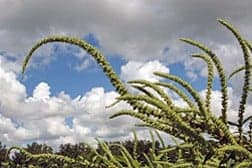A naturally occurring fungus may prove useful in the fight against Palmer amaranth, an aggressive southern weed that can grow at the rate of two inches a day and outcompete corn, cotton, soybean and other crops for resources, potentially reducing their yields.
To make matters worse, some biotypes of the weed have become resistant to glyphostate herbicides. As a possible alternative, U.S. Department of Agriculture (USDA) scientists in Stoneville, Miss., are exploring ways to formulate Myrothecium verrucaria, a fungus which attacks Palmer amaranth’s leaf and stem tissues, causing wilt, necrotic lesions, loss of chlorophyll, and other disease symptoms that can kill young plants and weaken older ones.
Studies by Robert Hoagland, Doug Boyette and others at the Jamie Whitten Delta States Research Center operated by USDA’s Agricultural Research Service (ARS) in Stoneville, indicate Myrothecium can wreak similar havoc on biotypes of Palmer amaranth that resist glyphosate and other herbicides such as triazines.
To test Myrothecium‘s infectivity, the researchers used a filamentous growth stage known as mycelium and sprayed a special formulation of it onto two batches of four-week-old Palmer amaranth seedlings: those with glyphosate resistance and those without. They repeated the same procedure with six-week-old plants. All groups were visually checked for symptoms over the experiment’s seven-day (168-hour) period and then weighed for reductions in shoot growth.
Seedlings were most susceptible, with all plants exposed to a full-strength application of the fungus showing disease symptoms. By 48 to 72 hours, nearly 100 percent had died. In six-week-old plants, symptoms progressed more slowly, but there was no significant difference in injury between glyphosate-resistant and glyphosate-susceptible plants. Both groups showed disease symptoms, most notably chlorosis, some necrosis, and stunted growth.
The findings, published in Allelopathy Journal, mark the first report ofMyrothecium‘s bioherbicidal activity against a weed species with glyphosate resistance.
Read more about this research in the November/December 2013 issue ofAgricultural Research magazine. ARS is USDA’s principal intramural scientific research agency.




A few years ago I did a science project on allelopathy – I tested several species for this survival mechanism and found that many species previously regarded as ‘innocent’ exhibit this toxicity. Thus one might not only have one’s inconsistency to blame for the barren patches under the trees in the garden and many more species than we thought could have bioherbicide possibilities. I postulated that these would have the benefit of no negative toxic effect on ecosystems, by only targeting specific weeds (e.g. No damage to fish downstream). However, it is not mentioned whether Myrothecium verrucaria also affects the growth of other plants i.e. the crops it is meant to protect? I assume one would have to identify a specific allelopathic species that is friendly to the crop one is trying to grow.
Manual control is the most efficient one in any case . Only draw back is not acting on it. In any case if man finds an incentive he will definitely act on it. This research is good and not decry. Why we should not look at the uses of the weed . Why the nutrients and their benefits to man if used as a herb will it not make the weed disappear? Can we find wheat as a weed unless it is neglected?